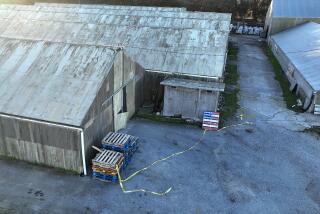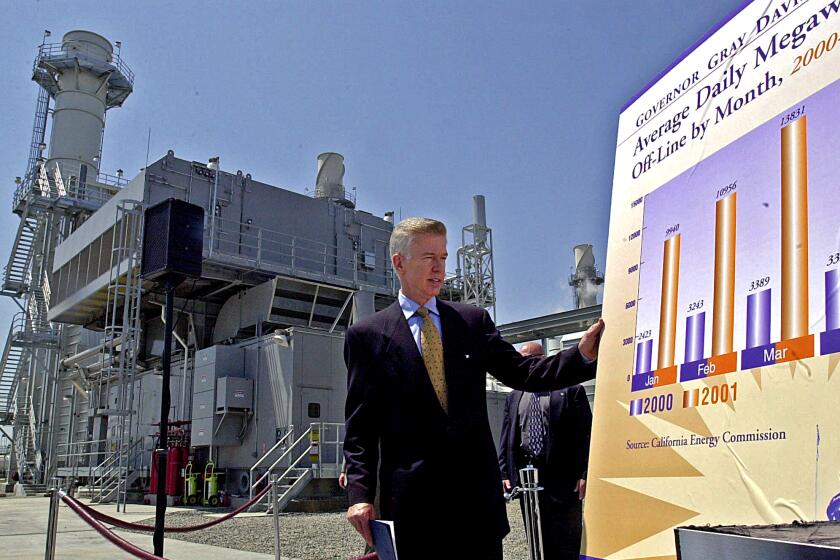State Fights Deadline for Removing Toxics : Environment: Contamination at Chatham Brothers site in Escondido is more widespread than earlier studies showed.
A 9-year-old program to clean up a toxic waste site in southwestern Escondido will begin in mid-March as state officials race to move the contaminated soil to an approved dump site before stricter federal regulations go into effect in May.
Soil tests made in December at the Chatham Brothers Barrel Yard indicate that the contamination is more severe and widespread than previously thought, John Kearns, regional chief of the Toxic Substances Control Division, part of the state Department of Health Services, told residents and community advisory board members Monday night.
Instead of the 400 cubic yards of contaminated materials initially estimated to be at the former bulk plant and oil recovery center, about 6,000 cubic yards (9,000 tons) of toxic materials must be removed, he said.
On May 8, federal regulations will halt dumping of certain untreated toxic materials into landfills and require that the soil be treated by “the best available technology”--a costly process of incineration that would raise the costs of disposal to about $11 million.
The site, which functioned as a petroleum recycling yard for 40 years, is now surrounded by new subdivisions, increasing the possible danger from the toxic materials such as heavy metals, PCBs, benzene and other oil derivatives.
Kearns said his division has obtained an additional $1 million from the nearly bankrupt state “Superfund” for toxic cleanup, enough money to remove the remaining contaminated soil. The total cost of the cleanup will be $2.5 million.
When neighbors objected to the sudden start of the program--without a 30-day review period and several public hearings called for in the cleanup plan--Kearns apologized, but pointed out that the removal would take about five weeks. That would bring the project to a close by late April or early May, before the federal regulations take effect.
“We’ve reached a time where we’ve got to stop testing and start acting,” John Scandura, chief of the site mitigation unit, told the small Escondido audience. Further funding will be budgeted starting in June to complete the process by restoring the site, he said, a process that will also be subject to public hearings.
The health department technicians raised their estimates from 400 cubic yards to 1,600 cubic yards of contaminated soil on the site after new tests last May, and increased the estimate to 6,000 cubic yards following the extensive tests done in December.
Karen Baker, project manager, and other health department staff members outlined the plans for removal of buried barrels and contaminated soil from the site, the safety procedures which will be taken and the findings of the most recent tests. The plans have not yet been put in written form, she said, because she received the complete results of the December tests only about 10 days ago.
Residents, who have been complaining about the slow pace of the cleanup, which started in 1981, found themselves arguing that the state toxic control officials were moving too swiftly. However, most of the community advisory board conceded there is no other alternative to the hastily constructed cleanup plan if the work is to get done with the money at hand.
Preliminary work will probably begin next week, Kearns said, if an approved dump site can be found. He said his division is negotiating with two sites, one in California and one in Nevada.
After two weeks of site preparation, removal will begin. Toxic materials have been found at the surface and as deep as 15 feet below ground, Baker said.
Plans are to use two pieces of earth-moving equipment to move 20 truckloads of the contaminated soil out each day. Work would continue six days a week in order to speed the removal, Baker said.
Before work begins, another public hearing is to be held to inform residents about the extent of the contamination and the methods of removal.
About 400 cubic yards of the most highly contaminated material from the site was removed to a hazardous-waste landfill last year at an estimated cost of $200,000. The initial cleanup last spring reduced the hazard of the site appreciably, according to a health department spokesman.
The Chatham family bought the 30-acre site, at Gamble Lane and Bernardo Avenue, in 1941 and began operating a bulk petroleum distribution and oil recovery processing plant there. In 1948, a still was added to reclaim kerosene and hydraulic oil. Solvent reclamation started at the site in 1965.
The property was sold to a housing developer in 1981, the same year the state Hazardous Substances Act was passed. The construction firm declared bankruptcy a year later and the land reverted back to Robert and Thomas Chatham.
State studies into the severity of the contamination at the Chatham site began in 1985.
More to Read
Start your day right
Sign up for Essential California for news, features and recommendations from the L.A. Times and beyond in your inbox six days a week.
You may occasionally receive promotional content from the Los Angeles Times.





